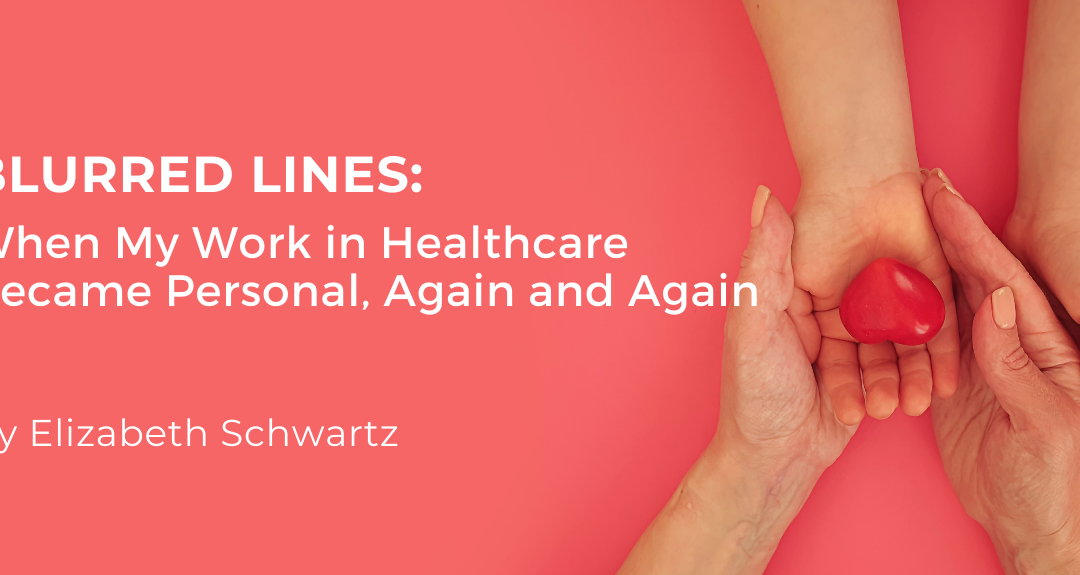
by Maria Meredith | Dec 6, 2023 | Blog
As an agency that works exclusively with healthcare, health IT and life sciences companies, this is a startling stat: U.S. hospitals waste over $12 billion annually as a result of communication inefficiency among care providers. Helping our clients succeed with clear, consistent communication is in our DNA for good reason.
Working with our clients as they seek to communicate clearly with their target audiences across the healthcare industry, the old marketing “Rule of Seven” still applies. Basically, this rule states that it takes an average of seven interactions with your brand before a prospect will take action, which in the B2B world may be to commit to a meeting. That’s why integrated marketing programs designed to communicate across multiple channels are so important in today’s noisy, cluttered media landscape. Here are several considerations to develop effective campaigns that deliver on the Rule of Seven.
Set clear, measurable campaign objectives
Always start with a clear understanding of who you want to target, what action you want them to take, and what information they need to understand how you can meet their immediate need. A common mistake is not segmenting the target audience into personas with specific needs that are met by your solution or service. Rather, it’s most effective to develop a strong value proposition for each persona and deliver your message through focused campaigns.
In addition, identify key performance metrics right up front for every campaign. With an eye to the objectives, how will you measure success – webpage visits, landing page conversions, meetings scheduled? Be sure to set a baseline and target results. As the campaign progresses, use the metrics to guide adjustments to continuously improve performance.
Create compelling content
In today’s content-rich environment, it’s vital to tell a coherent story about how you meet the needs of your target personas across all your channels, from your website to social media to thought leadership to campaign content and sales enablement assets. By first understanding the type and depth of information each persona needs at each step in the buying process, you can identify what content will be most effective for each campaign.
Offering a mix of content is an important aspect of the Rule of Seven. Different people within your target audience will respond best to different types of content. Some focus on short-form content such as social media posts, infographics and videos. Others prefer long-form content, such as articles, eBooks and white papers. Long-form content can always be repurposed into short-form content, which more effectively uses resources while delivering consistent messaging. Overall, it’s important to deliver a mix that consistently drives them toward the final call to action.
Extend reach across multiple channels
Every integrated marketing campaign should leverage as many channels as possible to meet target audiences where they are – your website, social media, outbound email, digital advertising, search, events and tradeshows. And as highlighted above, use a mix of short-form and long-form, written and video to reach your audience. Pay particular attention to how to make content pop visually for each channel – over 50% of marketers agree that visual content is essential to their marketing strategy, leading to more engagement from audiences.
Align media relations and thought leadership efforts
It’s also important to create crossover between focused campaigns and proactive media relations and thought leadership programs. Published articles make valuable assets to incorporate in campaigns. By creating pitches that address the needs of journalists while connecting with the key messages for your target personas, you leverage another important channel for reaching your audience.
Integrated marketing programs that communicate across multiple channels using compelling content help rise above the noise and connect with your audience in ways that deliver results. With the Rule of Seven in mind, marketers can create meaningful brand interactions that show how your solutions meet the needs of your prospects, making them more apt to take the next step toward purchasing your solution.

by Jessica Smith | Mar 2, 2022 | Blog
Recently, I was listening to a podcast featuring the CEO of a healthcare tech company that’s doing fantastic things in a new way—an actual innovator, as much as that word is overused. The podcast wasn’t sponsored, so the line of questioning was broad and geared toward thought leadership. In response to the host’s first question, the CEO launched into a detailed explanation of the issues with just a quick “At [Company Name], we deal with [thorny topic] all the time, starting with A and B.”
The rest of the conversation bounced around from there, and it was a decent interview overall, except for one thing: I never found out what the CEO’s company did, exactly. I agreed with many of his sentiments about the industry and was already predisposed to think highly of his company, but the onus fell on me, the listener, to search online for more info. That CEO had one shot to make a first impression, but he failed to take advantage of it: he didn’t introduce his own brand.
As an account director, I see clients fail to effectively communicate their corporate message. When prepping for an interview, clients tend to focus on which successes to share. They talk about how to answer tricky questions that might come up, and discuss whether a data point from Client 1 or Client 2 would be best. But they don’t focus on the messaging basics: how to say what you do as efficiently as possible, in a variety of settings. Your leaders need to agree on the language they’ll use to give a quick introduction, and they need to practice this phrasing until it becomes second nature.
When I was listening to that podcast, if I had heard something like this: “At [Company Name], we provide [innovative feature] to [type of customers] to help them [accomplish this result]” before the CEO continued with “So we deal with [thorny topic] all the time…” I would have had a context for all the insightful things Mr. CEO said from then on. I would have been properly introduced to the company, grounded in what they provide to a particular market.
You Need More Pitches Than You Think You Do
At large companies, marketing departments will hammer out corporate messaging templates with several components: the top 3 bullets that describe the company’s accomplishments; the 25-word elevator pitch; the 50-word elevator pitch; the 100-word boilerplate; the corporate mission; the list of values. Smaller companies, being nimbler and more mission-driven, tend to think of such messaging docs as unnecessary—and completely disconnected from what their leaders will say to the press.
They’re not. Just as all companies must determine their market positioning, they must also determine their specific language: how will we introduce ourselves? Your company’s oral and written messaging needs to include both features and benefits. What do you make/provide/enable for customers, and how does that feature benefit them?
Once you’ve got your messaging down, you need to spend time iterating it in multiple formats. Contrary to popular belief, the best 25-word intro to your company is not the first sentence of your “About Us” page on your website. Be thoughtful about each version, and note who it’s for: 50 words to describe us to investors; 5 bullets to include on slides for existing customers; 3 key messages for trade shows; etc. This legwork will pay off in spades as you apply for awards, send reporters background information, complete RFIs, connect with potential clients, and more.
Lastly, don’t forget to train your leaders in the verbal version of your messaging for conversations and interviews. While it doesn’t need to be exact every time, you should certainly have at least one or two phrases that are consistently said aloud by your executive leadership.
Revamping Your Boilerplate
Found at the bottom of all press releases, a company’s boilerplate is a standardized paragraph that describes the organization’s purpose, size, and presence. It often includes details such as the year the company was founded, its annual revenue and/or financial backers, and market share or angle. Your boilerplate should also incorporate a few key words—or even better, a unique phrase—to enable search engine optimization.
Unfortunately, many companies write their boilerplate once and then forget to refine it as their messaging evolves. Along with your messaging, you should review your boilerplate at least once a year. Does it reflect where you are now? If your key phrases aren’t getting any traction, but your customers all respond enthusiastically to one specific value prop, consider the SEO version of that value prop. Will it work in your boilerplate? Is it clear and meaningful, or did you accidentally jargonize it?
While this is not an exhaustive how-to post about how to write an excellent company boilerplate—for that, see this post from PR expert Dmitry Dragilev—I do have a few tips for you.
#1: Don’t be aspirational.
If your company makes teapots, but your five-year plan involves the creation of compostable coffee, tea, and mimosa single-serve pods, you’re not an “major vendor in the eco-friendly breakfast beverage supply chain”; you’re still a teapot manufacturer.
Startups in particular are frequently tempted to include their overarching vision in their boilerplate, as they can’t yet do what they mean to do – and they want everyone to know the scope of their ambition. While this is understandable, companies run the risk of undermining their own success if they stake their reputation on future-state aspirations. Potential clients may simply want a beautiful teapot; they need to know that your company makes them.
Don’t let your excitement about what your company will eventually do overcome reality; market what you have now, and market it well. If you’re afraid that your company will be discounted because everyone’s talking about single-serve beverages, then find a way to incorporate your proximity to the Hot Topic without overselling what your company does in the present moment.
(Apologies to the Ask a Manager readership for the teapot analogy. This site answers reader questions on workplace dilemmas, and it’s well worth your time: the letters are often hilarious, and writer Alison Green gives useful advice for navigating difficult work situations.)
#2: Keep it modest.
This is not the time for verbs like ‘transform’ or ‘revolutionize,’ nor for adjectives like ‘impressive’ or ‘powerful.’ Your boilerplate should state what you do and why you do it, but not offer its own opinions on how well you do it. We don’t include self-referential compliments when we’re introducing ourselves for a reason. While you may call yourself “adept” in a cover letter, you don’t say it in conversation; your boilerplate should not be the corporate version of “I’m Jessica, a skillful communicator!”
You should also stay away from superlative phrases like “the industry’s leading platform” or “the world’s largest system,” especially if you’re relatively unknown. Even if your software has twice as many users as your closest competitors, comparative phrases invite readers to respond with skepticism. There should be nothing in your boilerplate that is arguable; your statements should be clear, simple, and unassailable.
If you work for Amazon, then sure, you could say you’re the world’s largest online retailer—but readers would know that already. For everyone else, it just sounds like a humble brag that may or may not be true. If you want to show size or range, opt for facts instead: “used by 65% of U.S. health systems” is more believable than “the industry’s leading platform.” If you’ve won a prestigious award, make sure to include it in your boilerplate. Let others do your bragging for you!
#3: Avoid nonsense taglines.
My husband’s favorite tagline of all time was for the beer Stella Artois: “Reassuringly expensive.” For 25 years, the company used this phrase in television and print ads in the U.K., where it hit just the right note: this beer tastes so much better than its low-end counterparts that it’s not even in the same category—nor are you, discerning drinker!
In corporate America, and especially in healthcare, there’s a tendency to choose random inspirational words for your tagline. Often these aren’t even connected to what the company does, but just a collection of positive qualities or actions: “Collaborate. Innovate. Accelerate.” Taglines should be clear, practical, and instantly relatable to what your business does, according to this advice from entrepreneurs.
In healthcare, I’ve seen many variations along the lines of “We move care forward” or “We put the care in healthcare.” Avoid stating the obvious (nobody moves care backward), and avoid being cheesy. Your tagline requires real thought and a sense of what sets your company apart from competitors. This is where you can get creative and evoke your company’s higher aspirations (as long as they relate to what you do now). Where do you want to be in ten years? What mission connects your present and your future?
You won’t be able to encapsulate every last thing that you do in one tagline, but you should be able to come up with an evocative phrase that distinguishes your approach. Don’t be afraid to test it out across your company, or ask your employees for help brainstorming. Once you have a good tagline, use it to close out your boilerplate, along with a link to your website. Now, you’re ready for prime time: You have everything you need to make a good impression.

by Megan Moriarty | Jan 5, 2022 | Blog
One of the foundational PR rules that any communications professional learns is to avoid the use of jargon – the technical terminology or characteristic idiom of a special activity or group, as defined by Merriam-Webster. In my years working in PR for healthcare and health IT organizations, this has been a permanent item on my list of interview tips, and any media training I’ve conducted has included guidance to avoid the use of jargon.
When communicating to a general audience, this is sound guidance and standard practice. Jargon is unnecessarily complicated, can confuse your audience and cause your audience to lose interest. If your audience has tuned out because they don’t understand what you’re telling them, they won’t hear or read your message.
It may be tempting to include technical language to demonstrate proficiency and credibility with particular subject matter. This is an especially tricky trap for those of us who work in specialized areas like healthcare and health information technology. But there’s a fine line between using familiar terms and wading into the murky waters of jargon.
As with any marketing content, one size does not fit all. Public relations and marketing must be specific to your audience. Using technical language can demonstrate competency and help build credibility, if the audience can understand it. That’s why it’s crucial to do your homework, research your audience and their level of understanding.
Get to Know Your Audience
In a recent Amendola Communications blog post, my colleague Jack O’Brien reminded us that PR representatives should take time to do their research on the journalists and outlets that they’re pitching. Not only will this help you target your pitches to topics of interest, but it will also help you tailor your language to the journalist’s readers and the publication’s audience.
This is especially true for any media relations professionals who work in a specific industry, as we do at Amendola Communications. We work with a variety of reporters – from those who write for publications focused on a specific medial specialty, to trade reporters with a deep focus on health IT, to healthcare beat reporters at major national publications, to general assignment reporters at daily newspapers. The audience and level of understanding for each of these reporters and publications will be different, and so should each pitch. As you can see, one size definitely does not fit all.
Write in a Manner the Audience Will Understand
Once you’ve done your homework and you understand your audience, you should also delve into their level of familiarity and understanding of the topic you’re pitching. For example, if a publication targets physician executives, you can safely assume the audience will understand basic medical terminology because of their medical education. A physician discussing cardiovascular health can thus feel confident that the audience will understand the term “myocardial infarction.
However, if that same physician is instead speaking to the general public about heart health, it would be more appropriate to use the more colloquial and widely understood term “heart attack.” A good rule of thumb when pitching to and writing for a general audience is to avoid using language that your Aunt Sally wouldn’t understand.
Always Keep the Reader in Mind
I’ll offer some sage advice that one my college professors, Steve Kopcha, shared from his decades of experience in strategic communications: “Say it square, then say it with flair.”
It’s easy to get so caught up in figuring out how to “say it with flair” that we forget to first “say it square.” In the simplest terms that Aunt Sally would understand, how can you communicate what your client’s product or service does? What problem does it help to address? Why does this matter for the reader?
A former communications colleague of mine who had spent years as a local news reporter offered a helpful way to frame this concept. She would ask me how I’d explain something to my next-door neighbor, and why it would matter to them. When you find yourself struggling with whether to use technical language, ask yourself what it will mean to the person reading the article you’ve pitched. Will it help further their understanding, or does it muddle your message? Keeping the reader in mind will help you to walk that fine line between technical language that helps to inform and jargon that muddles your message.

by Chris Nerney | Dec 8, 2021 | Blog
Smart healthcare companies invest in creating a quality digital presence, primary through their websites. I’ve launched my share of sites over the years and can tell you that a lot of planning, debate, creativity, and effort go into every facet of a company’s website, whether it’s brand new or overdue for a revamp.
Decisions must be made about everything that appears on a website – sections, design, images, and content. Writing content for a website is one of the most challenging jobs in content creation because you are under immense pressure to grab visitors immediately or risk losing them forever. A Chartbeat analysis of user behavior across 2 billion website visits showed that 55% of visitors stayed on a page for less than 15 seconds.
That’s why every word should contribute to telling a company’s story and positioning that company as unique in its market. I know from personal experience that creating website copy is a painstaking process of writing, rewriting, rewriting, hating your life, and rewriting. You can’t just dash off website copy! But the hard work invariably pays off for companies when their dazzling new website is launched.
While many startups are happy just to get their sites live – and it is an accomplishment – others have content plans that extend beyond the launch, such as a blog page. Which is shrewd because a steady stream of original content can demonstrate a company’s “thought leadership,” the ability of its executives to understand the business-critical issues and pain points facing its customer base. Further, blogs provide an opportunity for startups to establish a human connection (podcasts also are excellent for this) with potential customers, partners and investors.
Unfortunately, many startup blogs begin with a lot of energy and enthusiasm and then succumb to the harsh realities of continual content generation. Maybe the team member who championed the blog and did the bulk of the writing got another job. Maybe the CEO or CMO are too busy to contribute the monthly posts they promised. Stuff happens.
The problem is that a blog page containing only three or four posts, of which the most recent was from two years ago, doesn’t reflect well on your company. It looks like you don’t follow through or you ran out of ideas. Worse, you’re losing a chance to showcase the thought leadership that can separate you from your competitors in the minds of potential customers. Remember, many visitors to your site are actively searching for a solution. Your thought leadership content, in conjunction with the marketing content you perfected prior to the website launch, can be the differentiator that wins business for your company.
A blog page (or a section for videos or podcasts) won’t help your business at all, however, if it’s gathering cobwebs. I would argue that no thought leadership content is better than outdated content or a threadbare page.
Indeed, many healthcare startups make a conscious decision not to create a steady stream of content for their site, opting instead to focus their full efforts on the products and services they offer. That’s a valid decision if they truly lack the internal resources or budget to sustain a quality content creation program. And I suspect most visitors to a healthcare startup’s website probably don’t judge the company based on its lack of a blog. Conversely, a thinly populated and outdated blog/video/podcast section may leave a bad impression to website visitors, who likely won’t return.
Healthcare startups don’t have to publish fresh content every day or even every week to have a successful content strategy. Even a blog post a month can help you deliver your message and raise your profile if the content offers something of value for visitors. It can’t just be generic blather that checks off SEO boxes and gives you something to share on social media. Your content should position your company as a unique voice addressing serious, specific business challenges with effective solutions.
If your company lacks the bandwidth or skill set internally to produce content on a regular basis, freelancers can fill the gap, though the quality of content producers out there can vary wildly. That’s why working with an agency such as Amendola Communications is a sensible option. A marketing/communications agency specializing in healthcare can match the right writer to the right client, increasing the odds that the client’s content strategy pays off.
Website content isn’t easy and it isn’t free. But it can be incredibly valuable if it helps raise a company’s profile, which can attract customers, the media, and investors. Consistency and quality are the keys.

by Elizabeth Schwartz | Nov 24, 2021 | Blog
When I was a little girl, I always wanted to be a pediatrician. And a writer. I had no idea as an idealistic young lady that there wasn’t really a career that combined the two disciplines.
And when I learned how long I had to go to school to be a pediatrician, I leaned in a little more on the writing.
It wasn’t until I had leaned way into writing and four years of Journalism school that I got my first job at a multi-hospital research health system. I learned quickly that I could combine my three passions—helping people, healthcare and writing. I was not the one performing the lifesaving transplants, but through my writing I got to share the stories of two sisters who shared a lifesaving kidney transplant and encourage others to be organ donors. It was a great fit. I thought of it as writing. I had learned in Journalism school how to write a lead, a body and a close. I never thought of what I did as storytelling.
Then, as if it couldn’t get any better, I got a job as a writer at a pediatric hospital. I met awe-inspiring families struggling through unimaginable heartache but taking me along and allowing me into their lives to tell their story and show how they battled adversity with strength, bravery and grace.
I got to see the loving way nurses and doctors approached children and their families. I got to see the way parents looked bravely at their children and told them it was going to be OK even when they weren’t sure. I was humbled and grateful for each and every family. I remember thinking that I was so glad to be able to tell their stories but could never imagine being in their shoes. I had found my place: healthcare and writing. But then something happened that changed my perspective completely.
The Tide Turned
About two years into my job, I had children. My son and daughter are 18 months apart in age. When my daughter was six months old, she began to have seizures. We spent weeks in the hospital trying to find the root cause—from a brain tumor to epilepsy—what we found was that she had a stroke at birth and had cerebral palsy. When my son was two, he was diagnosed with autism. What had been unimaginable to me about the lives of those parents had become my life. We spent many days and nights with doctors, nurses, therapists—my colleagues—and now my child’s caregiver. I was the one of the parents that I had been writing about.
Why It Matters
My children have been a consistent source of joy and inspiration to me. I know that doesn’t make me unique as a parent, but when they were young, we journeyed through a lot together in ways I never thought I would experience. All the times I wrote those patient stories, I never knew one day it would be me.
I’m happy to report they are both thriving, active teenagers now. What I learned is that in some way for all of us, healthcare is personal. Whether it’s an aging parent, your own health challenges, or a child, when we walk through our healthcare system as a patient or a caregiver of a patient, it changes us.
For me, it changed the way I write. It changed the way I tell the story of the latest innovation in EHRs. It changed the way I appreciate the passion and selfless care that every single position in the healthcare ecosystem puts into what they do.
I think it’s easy as PR and Marketing professionals to get robotic and apathetic in the way that we amplify a brand or write a blog. What we should remember is that at the end of that journey is a real person with a real story. And you never know when that might be you. Write with your heart. Bring your own story in the passion you have for what you do. It will never steer you wrong.




